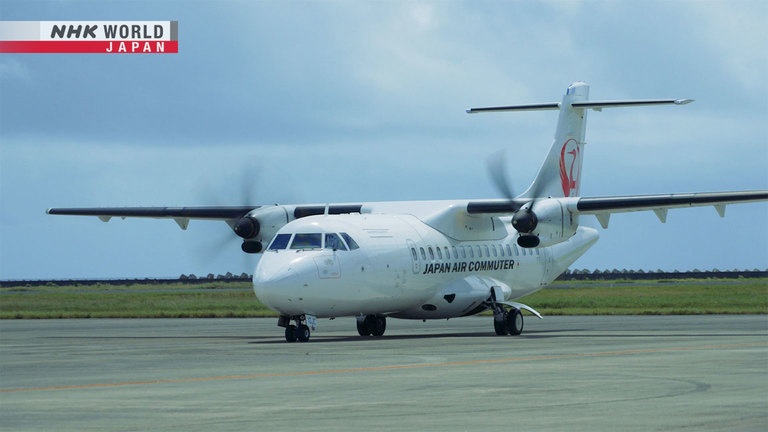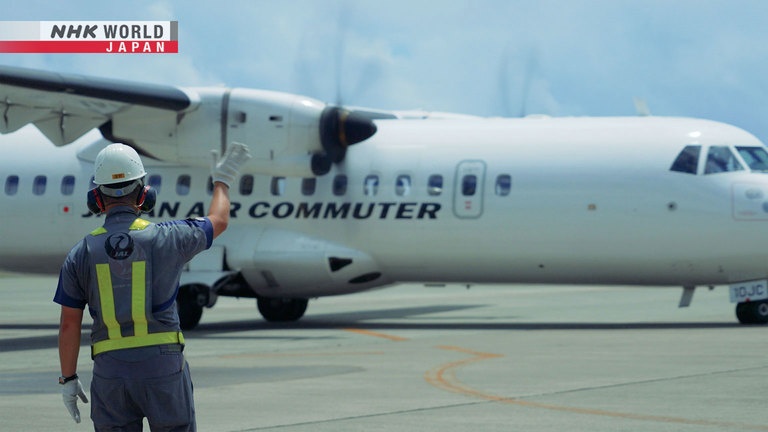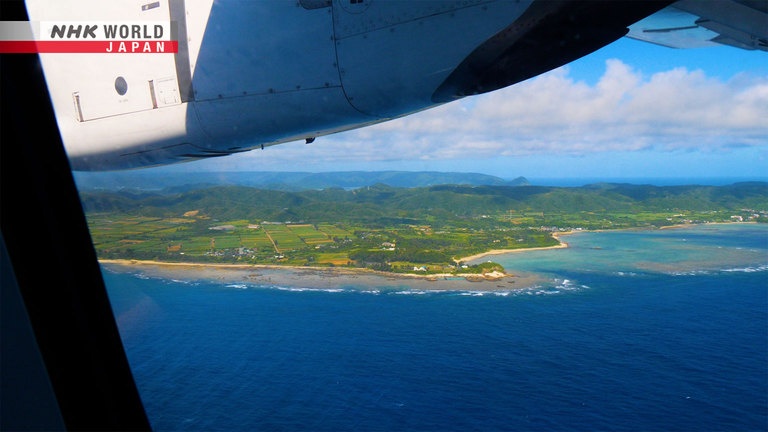#04 Kagoshima to Amami Airport
Hop on a plane and view Japan from the sky! This time, we head to Amami Oshima Island, off the south of Kyushu, riding on local propeller aircraft. A flight attendant who resides there guides us around the grand nature of Amami, which was just registered as a UNESCO World Natural Heritage site. We do activities, explore the island's food culture, and even folk songs. Also, we look at the work of mechanics who support the safety of airline travel to and from the remote islands.




Transcript
16,000 feet up in the air.
Come along on a brilliant visual journey through the skies above Japan.
We're heading to a Natural World Heritage site, Amami Oshima island.
Fly with us to the southern paradise, where summer is in full swing.
"On the Wings."
It's mid-July, and we've come to Kyushu's Kagoshima.
It's a prefecture with over a thousand islands, including Amami Oshima.
We'll depart from Kagoshima Airport, and head approximately 390 kilometers south, to Amami Airport.
But before the flight, let's take a spin around town.
Floating four kilometers off the coast of Kagoshima city, the ever-erupting Sakurajima.
As one of Japan's most active volcanoes, it's a symbol of this city.
One Kagoshima specialty is locally-raised chicken.
They even eat it as sashimi - that is of course, raw!
Another specialty is a breed of black pig.
"Shabu-shabu," where thinly sliced pork is quickly dipped in soup stock, is a true delicacy.
About a 40-minute drive from the city center.
We've arrived at Kagoshima Airport.
With 15 airlines operating, the airport connects with 17 domestic airports and four cities abroad, including Korea and China.
On the third floor of the airport, there is a free aviation exhibition room.
Here, you'll find a nostalgic flap display information board.
And there's a flight simulator that lets you navigate routes departing from Kagoshima.
Outside the ground floor entrance, there's a foot bath - something quite rare for an airport.
This is a natural hot spring from 1,500 meters underground.
Kagoshima is one of Japan's premier hot spring regions.
These hot springs are generated from a wealth of volcanoes.
In fact, our route today will be taking us along the active volcanoes of Kagoshima.
Our departure is at 7:40 a.m.
It's about an hour and 15 minute flight.
A shuttle bus takes us to our plane.
We'll be flying on a propeller aircraft that seats 48 passengers.
In contrast to most large aircraft, the entrance is at the rear.
After boarding, you proceed along the aisle, toward the front of the plane.
The Amami region, where we're headed, has just ended its rainy season.
Now, it's time for takeoff!
After takeoff, we make a wide turn to the left and set our course south.
One of the biggest features of propeller planes is the better views they can offer from the window.
In contrast to the 40,000 feet flying altitude of jet aircraft,
propeller planes fly at less than half of that, at just around 16,000 feet.
10 minutes after departure, the first active volcano we can see is Sakurajima.
Next, we're treated to the sight of Mount Kaimon.
It's an active volcano with a conical dome, reminiscent of Mount Fuji.
Twenty-five minutes after departure.
We've left the skies over Kyushu and venture out over the East China Sea.
The first remote island that comes into view is Kagoshima's Takeshima,
a small group of islets inhabited by merely around 60 people.
Shortly after, we spot Satsuma Iwojima, an island born of a submarine volcano.
Its geothermal hot springs tinge the shoreline with a palette of assorted hues,
creating a spectacle of nature's artistry.
Good afternoon, passengers.
Thank you very much for flying with us
to Amami Airport.
To the front left, you can see the
World Heritage site, Yakushima.
Yakushima, registered as Japan's first Natural World Heritage site in 1993.
This island is home to mountains over 1,000 meters high,
and is known for its primeval forests of Yakusugi cedar, some of which are over a thousand years old.
About 10 kilometers northwest from Yakushima, Kuchinoerabujima Island emerges.
This island is home to a continually erupting volcano, cohabiting with approximately 100 residents.
Forty minutes into the flight.
As we pass by the Tokara Islands, we begin our descent.
Amami Oshima comes into view.
From here on, we're entering the subtropical southern islands.
We have arrived at Amami Airport.
The airport is served by five airlines.
Apart from offering direct flights to major cities like Tokyo and Osaka,
it also plays the role of a gateway to the eight inhabited islands of the Amami archipelago.
Amami Airport is staffed by professionals who support air travel in these remote islands.
Among them is Kanno Akihiko, an aircraft mechanic with 29 years of experience.
Out of the five airports in the Amami Islands, Amami Oshima is the only one with stationed mechanics.
It acts as the frontline for ensuring the safe operation of the remote island routes.
Of course, safety is paramount.
It's a given.
Providing utmost peace of mind
to everyone on board is our role.
When problems with aircraft occur on an island without a mechanic, staff from Amami are sent.
We take the necessary tools and parts
to repair and return the aircraft.
With this airline, 11 of their aircraft operate approximately 70 flights daily.
The plane we took earlier from Kagoshima at 7:40 AM, heads to Kikai Airport immediately after arriving at Amami.
When it returns to Amami, it then flies to Yoron Airport.
And from there, to Naha Airport in Okinawa.
After another return to Amami, a second round-trip to Kikaijima.
And finally, at 6:40 pm, its back to Kagoshima Airport.
This one aircraft covers nine routes.
This means just one aircraft breaking down can cause delays or cancellation for the subsequent flights.
We try to avoid stoppages out here.
If a plane is grounded,
we can't switch to buses or trains.
The Amami team of this airline includes three mechanics.
They share the responsibility of checking the nine flights that arrive each day for any abnormalities.
I shine my flashlight, point with my right
and call things out, like "Screws, good!"
This way of pointing and calling
makes it clear where you are focusing.
No bird strikes.
No fuel leakage.
Kanno pays extra close attention to the propellers.
We check each blade for any damage.
When they spin, they're like a
4 meter diameter disk.
That's plenty large enough to hit something.
After an exterior check, he moves inside.
Greetings.
- The ship's normal.
- OK.
Kanno talks to every crew member to ask about the aircraft's condition.
Building relationships where you can
communicate freely is key.
This helps to gather information
about the plane.
Take care, and have a safe flight.
OK! No abnormalities.
Thank you for waiting.
Safe travels.
It feels good when we release the plane,
knowing the flight went smoothly.
I always look forward to seeing
passengers waving their hands.
It's nice to think they recognize our role
in their visit to Amami.
Our guide for Amami Oshima is...
Welcome to Amami!
Cabin crew, Mochigi Kinuyo is an Amami resident.
She was chosen as a local ambassador to promote the island by the airline where she works.
She moved to Amami in 2022, and has been promoting the island's charm nationwide.
Amami Oshima has a subtropical climate.
The average temperature is over 20°C.
After the rainy season,
July is nice and sunny.
Amami Oshima was just registered
as a World Natural Heritage site in 2021.
An activity you can't miss here
is canoeing.
We're heading to a mangrove forest now!
At high tide, you can explore the tunnels
created by the mangroves.
Our guide for the World Natural Heritage site area, Uken Village, is a local eco-tour guide.
Hi, I'm Matt. I'm from Australia.
Amami Oshima was registered as a Natural World Heritage Site
as it contains unique ecosystems that are habitats for many rare and endangered animal and plant life
that exist only in Amami Oshima - nowhere else in the world.
Amami's famous for brown sugar shochu!
It's an alcoholic beverage only permitted
to be produced in the Amami Islands.
It's made from sugarcane and malted rice.
A traditional home-cooked Amami meal!
Island vegetables and slow cooked pork.
To finish, boiled thin noodles stir-fried
with island vegetables.